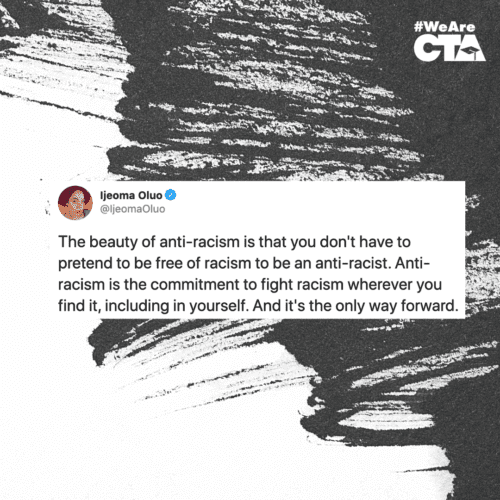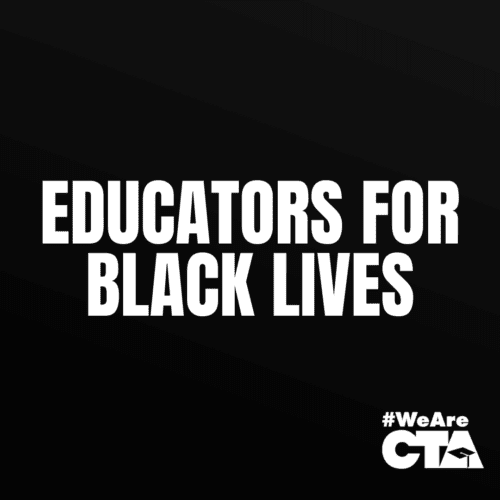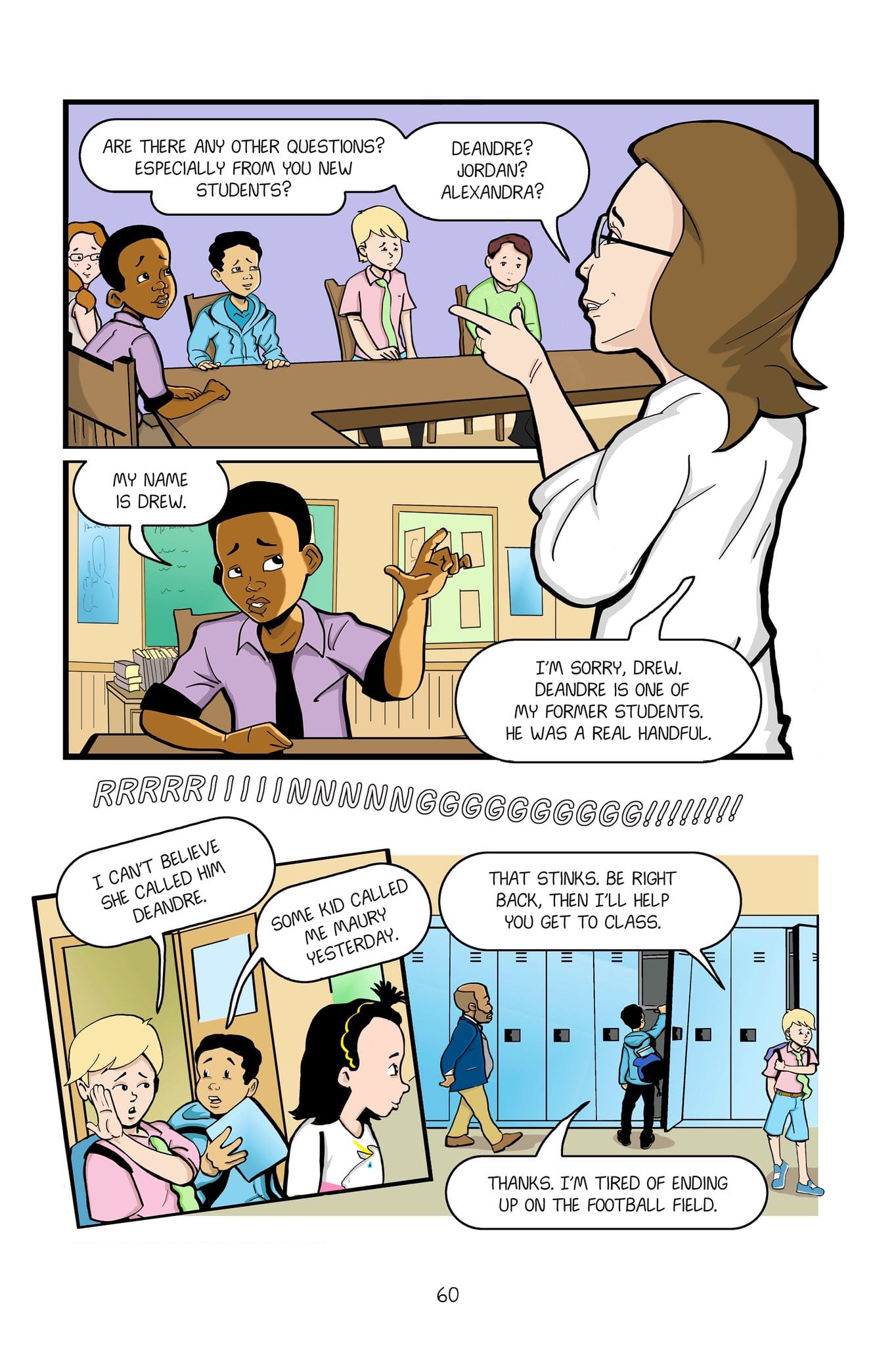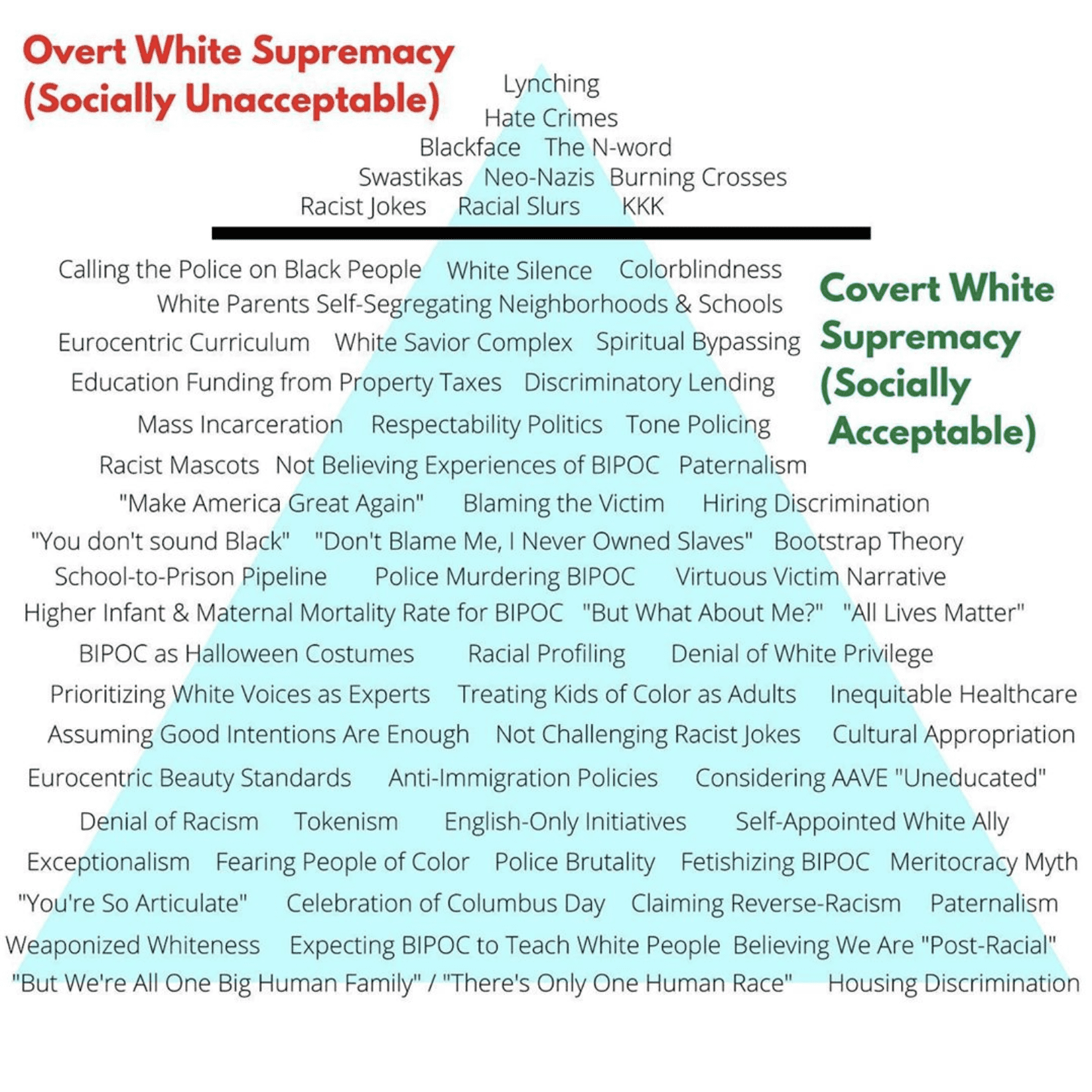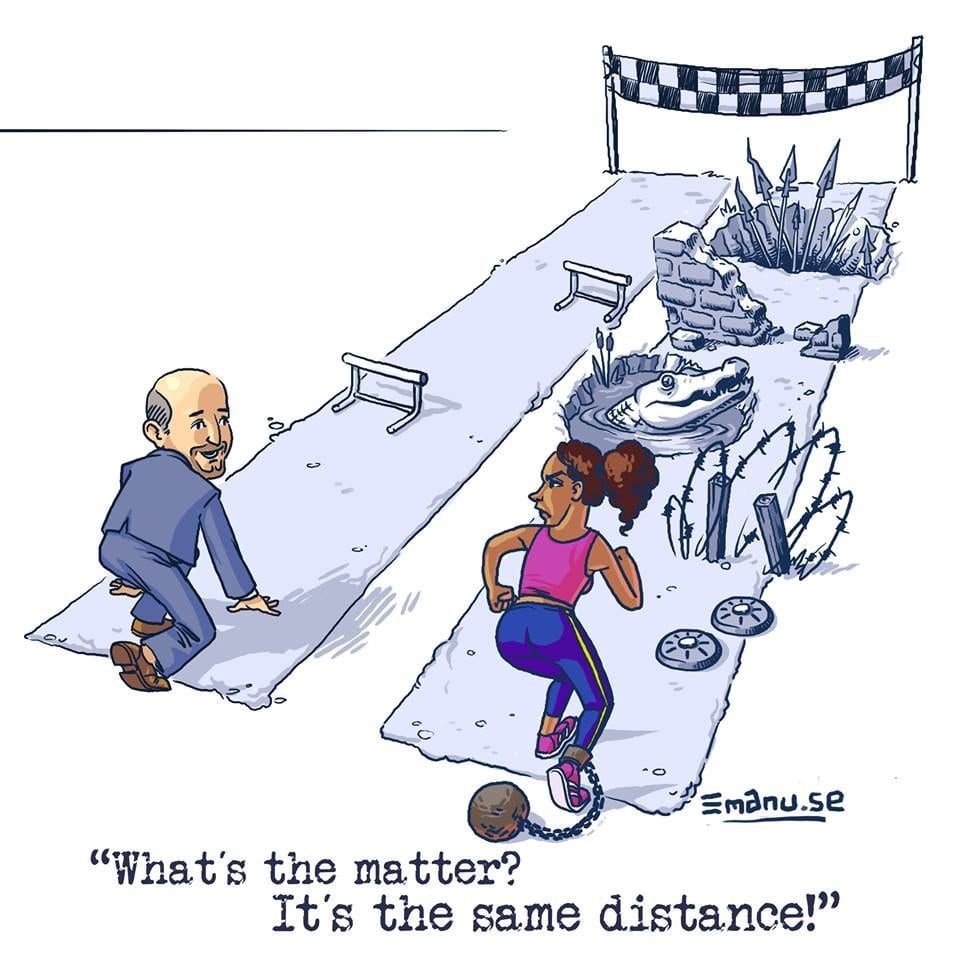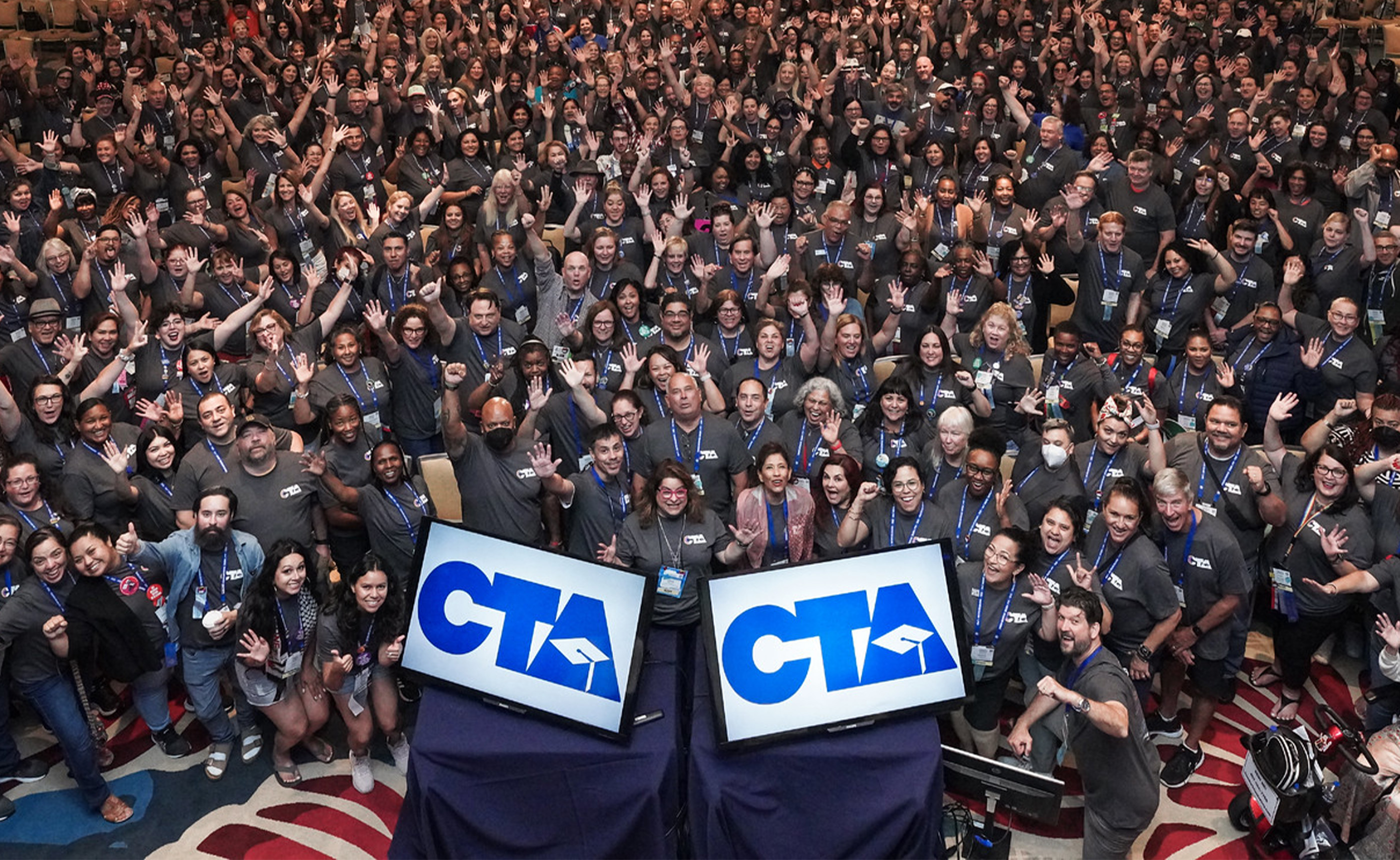Every day is a good day to fight for racial justice. Saying Black Lives Matter isn’t enough: we need to actively show it in our work toward anti-racism on a personal, structural and institutional level. We are grieving and we are outraged. Together, we must continue the call for justice and hold powerful people, organizations and each other, accountable. Join us to commit to anti-racism work every day.
“A highly organized system of ‘race’-based group privilege that operates at every level of society and is held together by a sophisticated ideology of ‘race’/color supremacy. Racism has a component of power and privilege.”
—Noel Cazanave, Darlene Alvarez Madden, Sociologists
Racism
Because racism is a highly organized system, it operates on an individual and institutional level.
Individual: Comments, looks, talking over people, dismissing ideas and other interpersonal behaviors.
Institutional: Policies, practices and unwritten norms as well as the ways people uphold these practices.
“In a racist society, it is not enough to be non-racist, we must be anti-racist.”
—Angela Davis
We want to know what you think!
- What does racism look like on an individual level at your school/district?
- What does racism look like on an institutional level at your school/district?
- What is the history of racism in the U.S…..California…..your community?
- How does the history of racism manifest in public education?
- How are you working and teaching for Black lives?
- How are you making your classroom a more racially just space?
- How can we commit to anti-racism in our everyday lives — not just when there is unrest across the country?
Racial & Social Justice Webinar Series
Join REAC and CTA Equity Teams for Racial & Social Justice webinars every other Tuesday.
Speaking Out
On social media:
As a union of 310,000 educators across California, we have an obligation to act. This is not a time for us to look away. We must grapple with the fact that our schools, our practices, policies and even our own union, are shaped by inequities, bias and institutional racism.
Our black students and educators experience schools, the police and this pandemic very differently than our white students and educators. Saying #BlackLivesMatter isn’t enough: we need to actively show it in our work toward anti-racism on a personal, structural and institutional level.
We are grieving and we are outraged. Together, we must continue the call for justice and to hold powerful people, organizations and each other, accountable. What are you doing to work toward anti-racism every day?
We are grieving, and we are outraged by the hateful racism and white supremacy that continues to terrorize our communities of color. The murders of George Floyd, Ahmaud Arbery and Breonna Taylor demand that we, as educators and Americans, recognize and confront the institutional racism that exists in our systems and structures.
We cannot allow this moment to define us as a society and as a nation. It is our responsibility to work to abolish racism on a personal, structural, and institutional level beginning in our schools and colleges. It is our responsibility to have these conversations at the dinner table and in our places of worship. This is not a time for us to look away, but to confront for the sake of a fair, just, and equitable future for all students.
The past 11 weeks have shined an even brighter light on the divide, and we have seen, firsthand, that our black students and educators experience schools and the pandemic differently than many, if not most, of our white students and educators. Saying #BlackLivesMatter isn’t enough. Together, we must continue the call for justice and to hold powerful people, and each other, accountable. We must come together to stop the chorus of hate and fear and utilize our people power, both personally and at the ballot box.
The National Education Association understands the deep racial history and trauma caused by the culture of white supremacy, and we believe that to achieve racial and social justice, we must acknowledge it as the primary root cause of institutional racism, structural racism, and white privilege. It is a privilege that manifests as white people weaponizing the police against black men and women going about their daily lives. During this pandemic, we have also seen police treating black and brown people differently than white people. The overarching sentiment about these cases for so many people—including many of our students and their families—is that the lives and the dignity of black people in the United States do not carry the same value or importance as others.
Our grief and outrage over the recently released images of the murders of George Floyd, at the hands of Minneapolis police, and Ahmaud Aubery, at the hands of two white men with ties to the local police department, will never be enough. For Breonna Taylor, who was murdered by police while daring to sleep soundly in the safety of her home, our grief and outrage will never be enough. And for Christian Cooper, who endured a white woman weaponizing the police against him in Central Park, our grief and outrage will never be enough.
This is no time for us to look away. Police violence against black people happens too often. The threat and real violence toward black people daring to exist in public spaces and even in their own homes is the direct result of how white supremacy culture is the air we breathe in America.
As a union of 3 million educators, stretching across the country, to every community, we have an obligation to act. Together we will continue the call for justice and to hold powerful people to account.
But in addition to that, there is more we must do. While our members don’t enforce the law, we are protectors of another public space wrought with inequities, bias, and institutional racism. While we have to stay engaged in elections all the way down the ballot in support of people committed to reforming the system and making change in local policing, we must also examine how white supremacy culture impacts our biases, our practices and the policies in our own schools and communities.
NEA has started that process by examining how white supremacy culture impacts our own organization. We have to seek the truth. But information is just one step that can lead to meaningful action. If you stop at information, you have done nothing. We must act on what we know. And so, we say: Black Lives Matter… because All Lives have not Mattered. Racism takes black and brown lives. Explicit racism foments hate and aggression. But implicit bias grows unreasonable fear and suspicion, moving people to act unreasonably on their fear and suspicion. We must do better.”
- Community College Association Statement
- Natomas Teachers Association Resolution
- Student CTA Statement
- Twin Rivers United Educators Resolution
- United Educators of San Francisco Creation of Racial & Social Justice Committee
- United Teachers of Richmond CTA/NEA Resolution
- United Teachers of Richmond CTA/NEA Memo to WCCUSD Board of Education
- West Contra Costa Unified School District Resolution
*Views expressed here are those of local chapters and affiliates and don’t necessarily reflect official policy or position of CTA. Read CTA policies and bylaws.
How is your local chapter or affiliate working toward anti-racism and supporting your Black students, educators and communities? Share with us in the Google form below. 👇
How can we work toward racial justice in our classrooms, schools and districts? How can we teach for Black lives every day (not just right now)?
From Instagram:
Focus on trauma-informed education to help students heal from pain
Put money into low-income districts
Use strategies to reduce disproportionately in Special Education
Hold admin accountable for disproportionate POC suspensions and expulsions
Updating diverse children’s literature
Take a look inside first. Educate yourself first.
Hire more teachers of color!
We need to make sure we are teaching the REAL history of our nation – even if it’s hard
From Facebook:
Marilyn Martinez I am a teacher protesting at pan pacific park in Los Angeles
Cindy Villalobos As educators it’s so important for us to take a stance. As a history teacher, I’ll keep addressing and discussing the history and presence of racism and inequity through my lessons.
Nicole Worthy Thank you for caring and speaking out. It’s easy to feel invisible when senseless tragedies such as this occur. It’s comforting to know African Americans are not in this fight alone. #WeAreNotOkay
Deirdre Selby-Gius As a white teacher choosing to teach in a community of black and brown students… these are my kids being killed! I love them! They are my babies!
ミラー・ アキーム As a black teacher, thank you for posting this. This was needed to be said and should be echoed throughout all walks of life but especially in education.
Marisa Pierucci I’m having open discussions with my friends of all cultures and colors. I have a bunch of books on order to educate myself and help teach my own children.
Taunya Jaco As a Black teacher, THANK YOU 🙏🏽💙✊🏽. It means the world to be seen and supported.
Jacquella Payne Great to know that an organization that supports students & educators is taking a stand to ERACISM. Thank you!
Jessie Montano Racism is still here. I still suffer it. However, the saddest thing for me is that I have suffered it more [from] my peers.
Sharena Reneé As a black teacher, thank you for posting this and showing your support.
Tina Sherree’ Chonis Embrace Hope for Change. 💔🖤🧡
Jennifer Todd-Andrew Feeling helpless. So sad to see the negative comments from the protest in my community today (La Mesa). I stand with the voices that have been unheard for far too long. In my lifetime, I’m so tired of injustice and those that abuse their power living without the consequences of their action. I am white, but I teach all children and love them all. Even when adults, those are MY kids being brutalized and MURDERED. They are mine, because they have been in my class and I love them. We should all be outraged by the continued injustice and lack of consequences for those in power. Shame on all who are not angry.
Arpi Cal Using cultural relevant material to celebrate the contributions of all the cultures represented in my class and helping students become self-aware of the role they play in ending racism…. I remember the words of Dr. Martin Luther King, Jr. who reminded us that “Peace cannot be kept by force; it can only be achieved by understanding. Darkness cannot drive out darkness; only light can do that. Hate cannot drive out hate; only love can do that.”
Susan Chen I purposefully choose books that have Black and Hispanic characters. I point out the lack of diversity in magazines I read to my students and family and have emailed publishers about this. I have made mistakes in the past and have many more to come, but I’m trying to learn from them and continue fighting for human rights.
Susan Stratton We as educators can do much to shift perceptions in our society but it will take a committed and well thought out plan of action. Not just words.
Bobbie Chavez It’s so much more than teaching. It’s about truly believing and living what we preach. To understand that this is deeply integrated into our society, into our structures, into who we are as a society. Empathy and sympathy are two very different emotions, neither of which relates to the years of racial injustice and inequity. Empathy requires walking in someone else’s shoes, sympathy requires pity. Do not pity the person of color who has survived! The word that needs to be shouted is remorse. Remorse for ignoring, remorse for inaction, remorse for allowing. We as teachers are required to look deep into our own souls and model deep remorse.
Carola Perisho Teaching history like it should be taught. Staying away from whitewashed curriculum. Making sure that all my students are represented in our literature not only during all the different holidays or designated months but every day.
Jennifer Dilly I am using my title as Educator to speak out on my perspective so that I can be a part of movement towards a greater place for us all. I am also using my voice as a Caucasian woman to make it known that I do not agree to such atrocities and to show my resolve towards union and equality for all.
Elizabeth Rubenstein EVERY public school that employs “resource” and police officers should follow suit and end those contracts.
Irene Dillon Project LIT, weneeddiversebooks.org, and NCTE have helped me grow and work through some of my feelings. Doing a book study this summer with colleagues on Push Out.
Meagan Townley Ordering some books for me and my kids. Change begins in our own hearts and homes. Then bring that love to the classroom and our reach is boundless. I no longer tell people I’m “not racist”-I am anti-racist. I’ve learned the difference. Know better, do better.
Nikole Kempi Scarlett When we are in professions of TRUST, such as teachers, police officers, and doctors, it is our responsibility to hold ourselves to high ethical standards. In every profession, there is that handful that tarnish our reputations. And in our profession, it is our responsibility to reflect on how well we are doing our job and to be willing to learn and improve our trade and relations with the public we serve. For educators, when there are reoccurring issues, like discipline or low academic achievement, it is our job with administrative leadership to address these to get better results, taking in consideration of the needs of the community we serve. Teachers must be prepared to acknowledge, respect and understand students with substantially different cultural histories and diverse backgrounds so to deliver curricula that reflects this and is accessible by all students.
Celia Harris Diverse Leadership is critically important in our institutions in order to combat injustice and inequality in them. Zaretta Hammond is a leader I look to for guidance on how to improve as a teacher and a person. Stay strong and continue to speak up – it’s what we tell our kids to do, so we need to live that and model it to build trust. We need community policing to build relationships in our communities and build trust and respect between all. We need policies that build capacity and opportunities for those communities where they do not exist. We need laws enforced equally with equitable sentencing, there is huge discrepancies in the justice system and all large institutions between treatment of wealthy and disadvantaged. So much to do, one step forward at a time, together!
A Message to Our Students from America’s Educators (NEA + AFT)
We teach to prepare our young people for their future—hopefully, for a better future. We teach to impart skills and knowledge. We nurture and support our students to help them build relationships and resilience. We teach them to dream. To think. To engage. To act. To make a difference. To lead.
And, often, our students teach us. Students have led some of the most powerful and effective movements for social change. Sixty years ago, the students who sat down at a lunch counter in a North Carolina five-and-dime store galvanized a national movement. Now students and young people are raising their voices in nationwide protests to demand an end to police brutality and for racial justice following the murder of George Floyd by a police officer.
As America’s public school teachers and school staff, we see you, we hear you and we stand with you. We also recognize the deep frustration and anger that people feel—both young and old—as a new generation of young African Americans watch the violence of modern-day lynchings and brutality by police. You have responded, peacefully and nonviolently, throughout the nation.
“Nonviolence is a weapon of the strong.” These words by Mahatma Gandhi are the foundation of nonviolent resistance. Martin Luther King Jr. used the lessons of Gandhi to power the American civil rights movement of the 1960s. Students and young people throughout the South stood together to wield the weapon of nonviolence and civil disobedience. Through their solidarity and persistence, they were able to challenge and overturn nearly a century of Jim Crow laws that forced Black men, women and children to live as second-class citizens. When their peaceful actions were met with extreme violence and police brutality, students and youth activists persisted. In early May of 1963, thousands of schoolchildren left their classrooms and headed to downtown Birmingham, Ala., to protest segregation. The entire nation witnessed the horrific images of those brave children as they were sprayed with fire hoses and attacked by police dogs at the direction of the city’s public safety commissioner, Eugene “Bull” Connor. In 1965, unarmed marchers in Alabama were attacked by police and local posses with tear gas and clubs on the Edmund Pettus Bridge during an attempted march from Selma to Montgomery. Rep. John Lewis, then a young leader of SNCC (the Student Non-Violent Coordinating Committee), was severely beaten during the march.
We are in the midst of three crises: a health crisis, an economic crisis, and a crisis of the continued failure of the American justice system, all made worse by the current president’s conduct and attitudes—a president who directs the police to fire tear gas and rubber bullets at peaceful protestors so he can have a photo op in front of a church; a president who threatens to deploy military forces to quash protests; a president who tweets the refrain of a racist former Miami police chief from 1967, that “when the looting starts the shooting starts.”
Yet you persist with peaceful protests throughout our land. This right to peacefully assemble is enshrined in our Constitution. And former presidents are with you. President George W. Bush wrote that this is a time to listen, not lecture. And President Barack Obama calls these protests a tipping point.
Of course, as you know, it is not enough. Even now, with the four officers arrested in the Floyd case, we must do more. We are confident that you will bring your power and voice to continue to raise awareness and organize. This November, your organizing—from the school board, to the statehouse, to the White House—will make sure that we elect decision-makers who will act on reform.
Racial equity is the great unfinished work of this country. You, our students, give us reason to hope. Even during some of the darkest days, young people have shown that they are willing to take a stand and fight for what is righteous and just. You are demonstrating the power of collective action. As educators, we are learning a timeless lesson from you that, together, we can change the world.
Activism is how we channel our anger to confront injustice. You are teaching us that. Your teachers are so proud of you. And the other caring adults who support your learning are inspired by you too.
Educate Yourself
Articles & Toolkits
- Reverse Racism Is America’s Favorite Myth
- The Racist Roots of American Policing: From Slave Patrols to Traffic Stops
- Racial Equity: A Critical Lens
- ‘A turning point’: California education leaders speak out about racism and police brutality
- Uprisings and Education
- Why you should stop saying “all lives matter,” explained in 9 different ways
- When the “white tears” keep coming
- How to be a good white ally, according to activists
- Microaggressions don’t just hurt your feelings
- NEA’s Black Lives Matter in School Resources
- Racial Justice in Education Guide
- Evolving Anti-Racism Resources
- Anti-Racist Allyship Starter Pack
- Racial Justice Organizing
- Dear White People, This Is What We Want You to Do
- A Guide to Equity and Antiracism for Educators
- Implicit Bias 101: A Look at Implicit Bias and Microaggressions
- 105 Things White People Can Do for Racial Justice
Books
- Teaching for Black Lives
- Ijeoma Oluo’s So You Want to Talk About Race
- Kiese Laymon’s Heavy: An American Memoir
- The Case for Reparations
- Essential reading guide for fighting racism
Black LGBTQ+ People to Learn About
Organizations Doing the Work
- Learning for Justice
- Black Lives Matter at School
- Zinn Education Project
- Rethinking Schools
- Black Visions Collective
- Black Lives Matter
- The Bail Project
- ACLU
- Unicorn Riot
- Know Your Rights Camp
Videos & Film
Accounts to Follow on Instagram
Anti-Racism: The active process of identifying and working toward eliminating racism by changing systems, organizational structures, policies, practices, norms and attitudes, so that power is redistributed and moves toward equity. See an expanded definition here.
BIPOC: Black, Indigenous, and People of Color. The term “builds authentic and lasting solidarity among Black, Indigenous and People of Color, in order to undo Native invisibility, anti-Blackness, dismantle white supremacy and advance racial justice.” (Source: The BIPOC Project)
Colorism: First coined by Alice Walker, colorism is used to refer to within group and between group prejudice and/or discrimination in favor of lighter skin tones and against darker skin tones. It isn’t racism, however there is a clear relationship.
Covert Racism: A form of racism disguised and subtle, rather than public or obvious. Covert racism is woven into the fabric of society and erases BIPOC through seemingly passive methods and underlying messages. See microaggressions.
Critical Race Theory: Activists and scholars interested in studying and transforming the relationship of race, racism and power. Educators are encouraged to read books and work by critical race theorists.
Cultural Competency: Skill development for work across cultural lines. *Not* about access to resources, power and privilege. *Not* about systems.
Decolonization: Work toward undoing, dismantling the effects of the oppressor/oppressed regime or structures imposed by a colonial power. For a classroom, this can mean unlearning and removing oppressive curriculum, language, images, norms, etc. (Sources 1 2)
Diversity: Awareness and appreciation of difference. It’s *not* about access to resources, power and privilege. *Not* about systems and it’s often very vaguely used. Many schools and organization hyper-focus on this, and need to move beyond it.
Microaggressions: A statement, action or inference that is indirect, subtle discrimination against members of a marginalized group such as a racial or ethnic minority. An example might be saying “You’re so articulate” to a Black person (underlying assumption being, it’s surprising you can speak so well for a Black person.) Some folks may refer to microaggressions as “Your racism is showing.” (See video 1, video 2)
Optical/Performative Allyship: Solidarity that only serves at the surface level to lift up and provide a platform for the ally. Makes a statement but doesn’t go beneath the surface and is not aimed at breaking away from the systems of power that oppress. (Source: Latham Thomas) Folks should work to center the movement, not themselves.
School to Prison Pipeline: A disturbing national trend where children are funneled out of public schools and into the juvenile and criminal justice systems. Most of these children are students of color, have learning disabilities and/or histories of poverty, abuse, or neglect. Instead of receiving additional educational and counseling support services, they are isolated, punished, suspended and pushed out.
Social Justice/Equity: Examines systems and history and how they impact individuals and looks squarely at access to resources, power and privileges, and asks “Who has it?” It’s about big picture and daily lives.
Racism: A system (consisting of structures, policies, practices and norms) that structures opportunity and assigns value based on socially constructed categories of people. It unfairly disadvantages some individuals and communities and provides advantages and access to others. The system of racism does not allow the realization of one’s full potential because it denies access to resources, power and privilege.
Whiteness: Like race, whiteness is a social construct rather than an essential characteristic or biological fact; is used as cultural property, and provides resources, power and privilege to those who are considered white, pass as white, or are given “honorary” white status
White Fragility: Describes the disbelieving defensiveness that white people exhibit when their ideas about race and racism are challenged—and particularly when they feel implicated in white supremacy. (Source: Robin DiAngelo). “White tears” are a symptom of white fragility.
White Privilege: The resources, power and privilege provided to people who are considered white; an exemption of social, political, and/or economic burdens placed on BIPOC; benefitting from societal structuring that prioritizes white people and whiteness.
White Savior Complex: Refers to a white person who assumes that folks of color need their “help” and “saving.” We see this trope play out in the media, racist curriculum and histories, choices made about traveling abroad, foreign policy, organizational structures and more. (Sources: 1 2)
White Supremacy: A historically based, institutionally perpetuated system of exploitation and oppression of continents, nations and peoples of color by white people for the purpose of maintaining and defending a system of resources, power and privilege.
Have a word or term you’d like added, expanded or edited? Let us know!
Caucuses
The CTA African American Caucus believes in the worth and dignity of all people. African American caucus members will have a key role in making policies and decisions that affect African American teachers and students and will actively participate in local, state and national teachers unions, associations and support the goals, objectives, policies and programs of CTA affecting African American teachers and students.
Caucus members advise, educate and lobby CTA State Council of Education and the CTA Board of Directors on issues of concern to the varying caucuses. Membership in CTA caucuses is open to all CTA members.
Antiracism is about doing and not just knowing.
—Leslie Mac, activist and community organizer.

